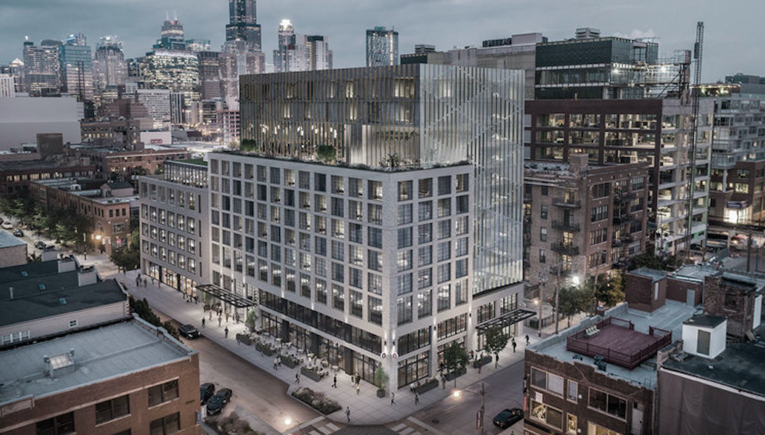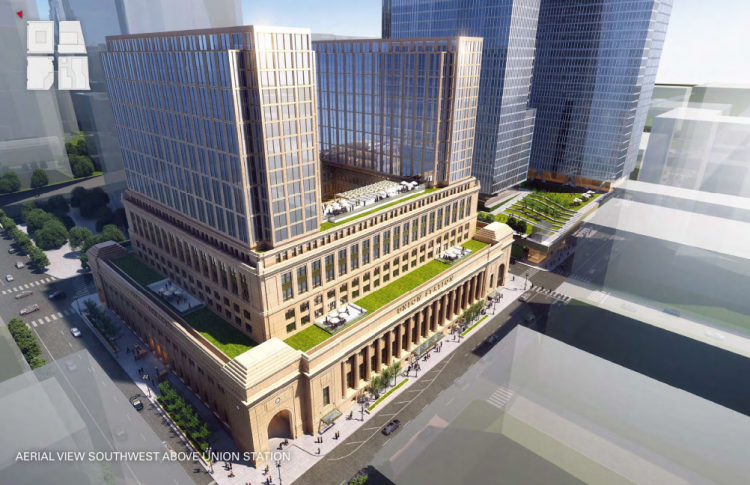As the development boom in West Loop continues, developers have shifted their focus to projects that attract a more temporary resident: the hotel guest.
Just a few years ago the only hotel you could find in the neighborhood was the 398-room Crowne Plaza at Halsted and Monroe. Originally built in 1960 and renovated in 2005, the property faced foreclosure as recently as 2013.[1] However the West Loop’s impressive recovery from the 2008 recession kept the hotel in business and caused developers to take note.
Fast forward to 2019 and the landscape has changed. In recent months, the Neighbors of West Loop Development Committee has seen a clear pattern forming: nearly every other new proposed project is or includes a hotel component. By our count, there are ten active hotel concepts in the works somewhere in the West Loop right now. This is especially true in Fulton Market north of Lake Street, where Ald. Walter Burnett has applied a moratorium on new residential properties. [2]
These projects will provide many benefits to the West Loop. Like any development, the new properties will add to the tax base and create hundreds, if not thousands of jobs. Some of them will also contribute to the Neighborhood Opportunity Bonus, which helps bring investment into local infrastructure. Hotel guests also provide a boost to the local economy as they visit nearby shops and restuarants.
However hotels also bring increased congestion, as most hotel guests will rely on taxis and other on-demand transportation network companies to come and go. More tourists may also lead to an increase in crime in the neighborhood, as would-be criminals target people unfamiliar with their surroundings.
Trendsetters

Shapack Partners was the first to realize the potential of the hotel market and partnered with a popular boutique hotel group to deliver Soho House (113 N. Green) in 2014. As most other developers waited to assess the viability of hotels in the neighborhood, a combined Hampton Inn/Homewood Suites (116 N. Jefferson) opened in 2016. Sterling Bay joined the trend and brought Ace Hotel (311 N. Morgan) to Fulton Market in 2017. Taking a smaller-scale approach, the popular Pulishing House Bed & Breakfast opened its doors at 1134 W. Washington in 2017 in a historic building that previously housed Free Methodist Publishing House.
For the next few years development in the West Loop settled into a rhythm: residential properties south of Randolph and office buildings north. Major corporations like McDonalds and Boeing decided to call the neighborhood their home. Companies that do business with these larger corporations soon followed, with projects like Sterling Bay’s “Vendor Village” at 210 N. Carpenter providing in-demand square footage. Examples include Coates Group, a digital display company, which is now headquartered at 112 N. May; self-order kiosk designer Acrelec, located at 1327 W. Washingon; and Creata, who designs Happy Meal toys from their offices at WeWork (220 N. Green). [3]
Between the burgeoning success of the newer hotels and the arrival of corporate headquarters, the ground was fertile for a restart of hotel proposals.

Hotel Takeover
Already bullish on the neighborhood, developers would not miss this new opportunity. Shapack Partners delivered Hoxton Hotel (200 N. Green) this spring, bringing Boka restaurants Cira and Stephanie Izard’s Cabra with it. Sterling Bay’s Hyatt House (113 N. May) followed in June to provide lodging for McDonald’s corporate visitors. After several starts and stops going back to 2014, Nobu Hotel (848 W. Randolph) is scheduled to open its doors later this fall (reservations are now available starting November 1). In total, these projects will increase the number of hotel “keys” (rooms) in the West Loop to approximately 1,500, not including short-term rentals like Airbnb.
With this backdrop, there are now a whopping TEN hotel proposals in the works for the West Loop. The proposed locations include a Pendry Group hotel at 1025 W. Fulton Market, a Dream Hotel at 215 N. May, an Equinox hotel at 725 W. Randolph, and a Tokoyo Hotel at 320 S. Clinton (which has faced opposition from Ald. Brendan Reilly). Perhaps the most visible of these is a proposed hotel atop the Union Station headhouse, which was approved by the City’s Plan Commission last fall. By our count, these new hotel projects would put the total number of hotel keys at 3,785.

Future Pendry Hotel at 1025 W. Fulton Market 
Proposed hotel atop Union Station 
Proposed hotel at 920 W. Lake
Summary of West Loop Hotels
| Name | Year Built | Addresss | Rooms |
| Crowne Plaza | 1960 (renovated 2005) | 25 N. Halsted | 398 |
| Soho House | 2014 | 113 N. Green | 40 |
| Hampton Inn/Homewood Suites | 2016 | 116 N. Jefferson | 338 |
| Ace Hotel | 2017 | 311 N. Morgan | 159 |
| Publishing House B&B | 2017 | 1143 W. Washington | 11 |
| Hoxton Hotel | 2019 | 200 N. Green | 182 |
| Nobu Hotel | 2019 | 848 W. Randolph | 119 |
| Hyatt House | 2019 | 113 N. May | 200 |
| Equinox | TBD | 725 W. Randolph | 165 |
| 1234 W. Randolph | TBD | 1234 W. Randolph | 289 |
| 800 W. Lake | TBD | 800 W. Lake | 199 |
| Union Station | TBD | 225 S. Canal | 330 |
| 310 N. Peoria | TBD | 310 N. Peoria | 28 |
| 920 W. Lake | TBD | 920 W. Lake | 200 |
| Pendry Hotel | TBD | 1025 W. Fulton Market | 200 |
| Dream Hotel | TBD | 215 N. May | 187 |
| Tokoyo Hotel | TBD | 320 S. Clinton | 615 |
| City Technology Center | TBD | 320 N. Aberdeen | 125 |
| Total rooms: | 3,785 |

A Transient Past
In some ways, the neighborhood is just rediscovering its roots. For much of the last century the West Loop was known as Skid Row, an “area of boarded up businesses, flophouses, dive hotels…” [4] It was a place to disappear from the world, where those suffering from the scars of war or overcome by the stresses of life would would take refuge. Many of the downtrodden residents, nearly all men, would wander the streets during the day and settle into one of the area’s 40+ men-only hotels at night, paying 50 or 60 cents to sleep in a 4 ft x 6 ft “room” lined with chicken wire.
The most famous (or infamous) of these establishments was the Starr Hotel at 617 W. Madison, where mass murderer Richard Speck was arrested in 1966. The hotel, along with many of the flophouses, liquor stores, and other buildings that made up Skid Row, was torn down in 1982 to make way for Presidential Towers and its parking structure, which was built on the site four years later. Within a matter of years Harpo Studios had arrived, along with the beginnings of Restaurant Row on Randolph, both of which began the path to the prosperous West Loop we know today.
What Lies Ahead
The question on many residents’ minds is “can the neighborhood support all of these new hotels?” Developers consistently respond by noting that corporate demand for temporary lodging is growing, as is the desire for tourists to base their travels in the West Loop. They also note that these projects would not be able to obtain funding if there weren’t a strong basis for hotel development.
Time will tell if these new hotels are meeting a need or oversaturating the market. In the meantime, they are in the West Loop to stay.
By: Development Committee Chair Matt Letourneau
July 28, 2019


